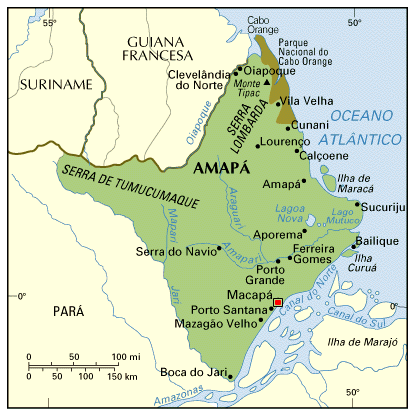BEHAVIORAL LANDSCAPE ECOLOGY
& CONSERVATION BIOLOGY
RESEARCH - Current projects
Advisor: Dr. Darren Norris Ecology and Conservation of Amazonian Vertebrates Research Group
INTERNATIONAL COLLABORATION with the Federal University of Amapá
Role of mammals as catalysts of ecological restoration in the Brazilian Amazon
Research topics:
1) How does the number and diversity of palm tree seeds dispersed by terrestrial and arboreal mammals differ between degraded versus intact tropical forests?
2) Do edge effects and seed supply modify the observed patterns of seed dispersal?
This material is based upon work supported by funding by the National Science Foundation (NSF) Graduate Research Fellowship Program (GRFP) through a NSF Graduate Research Opportunities Worldwide (GROW) Travel Award and by an United States Agency for International Development (USAID) Research and Innovation Fellowship.


The Federal University of Amapá is located in the city of Macapá, the capital of the state of Amapá in northeastern Brazil.
FAQs
What is the goal of this research?
Mammals that facilitate seed dispersal and germination can play important roles in supporting critical ecosystem processes and services. Whether mammals serve as seed dispersers or seed predators can vary within and among ecosystems for many reasons. Relatively little is known about how changes in mammal species composition (for example between undisturbed versus disturbed habitats) may lead to functional changes in the quantity and quality of dispersed or predated seeds. As a NSF Graduate Research Fellow at the University of Wisconsin–Madison (UW-M), I have been addressing these issues to understand the implications for post-wildfire forest regeneration in the western United States. Concurrently, researchers in the Ecology and Conservation of Amazonian Vertebrates Group (LECoV) at Federal University of Amapá (UNIFAP) in Brazil are beginning a long-term project to investigate the role of mammals as potential catalysts of ecological restoration in disturbed forests of the Brazilian Amazon. In these ecosystems, biotic vectors such as frugivorous mammals mediate much of the seed dispersal of tropical trees. The NSF GROW with USAID project proposed here will link efforts in the U.S. and Brazil to better understand the role of mammals in facilitating or impeding the regeneration of forests affected by disturbances and how this role varies between ecosystem types.
Why are you studying this (system/species)?
In Brazil, native palm trees (Family: Arecaceae) are economically and ecologically important plant resources in tropical forests affected by anthropogenic disturbances, which may create variation in food resources and habitat that could result in altered foraging behavior of animals. Therefore, the ability of animals to increase the rate and spatial extent of natural forest regeneration in disturbed tropical forests will depend upon the degree to which animals facilitate palm tree seed dispersal and germination as well as the spatial distribution of these processes. Terrestrial palm seed dispersal by frugivorous mammals such as peccaries (Family: Tayassuidae) and tapirs (Tapirus spp.) has been reasonably well-documented, but less is known about palm tree seed dispersal by arboreal mammals such as bats and primates. A rigorous, spatially explicit quantification of palm tree seed dispersal by arboreal versus terrestrial mammals in disturbed Amazonian tropical forests has not been conducted, but would be valuable to examine potential impacts on forest regeneration.
Why is this important to ecologists?
One central objective of ecology is to explore the link between ecological patterns and processes. Often, a consideration of spatial heterogeneity is necessary to explain this relationship. Behavioral landscape ecology, which seeks to connect organismal behavior with spatial patterns, can provide insights on ecological pattern-process relationships by analyzing the causes and consequences of spatial variation in organismal behavior. However, connecting these causes and effects can be challenging, especially if behaviors involve multiple organisms (e.g. plant-consumer interactions). Two questions need to be answered: how does landscape heterogeneity create spatial patterns of behavior, and how do these spatial patterns of behavior affect ecological processes? I propose to address these topics in a behavioral landscape ecology approach by examining the potential effects of human disturbances such as selective logging and mining on spatial variation in seed dispersal by mammals and implications of that variation for restoration of tropical forests in the Brazilian Amazon.
Why is this important to the public?
Tropical forests of the Brazilian Amazon are some of the most biologically diverse ecosystems in the world and are important sinks of increasing global atmospheric carbon dioxide emissions that contribute to climate change. As such, the Brazilian Atlantic forest has been identified as one of the highest global conservation priorities. However, widespread human activities such as selective logging and mining are degrading these forests, reducing biodiversity and hindering the sustainable management of natural resources and ecosystem services provided by tropical forests. Ecological restoration is a method by which biodiversity and ecosystem services can be improved, and restoration also benefits local human communities. Most Amazonian deforestation has occurred in Brazil, but within the country, the state of Amapá has historically had relatively low deforestation rates. Here and in other areas of the Amazon, restoration efforts undertaken in forests degraded by disturbances may be aided by their physical proximity to undisturbed, intact forests due to the effect of biotic vectors such as seed-dispersing animals, which are responsible for considerable tropical tree seed dispersal.
